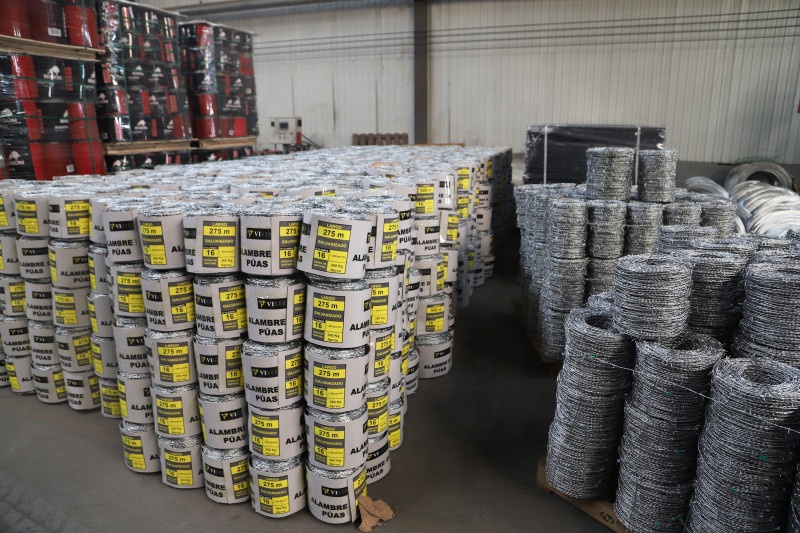Barbed wire (also known as barbed iron wire or razor wire) is a metal product widely used in security and protection fields. It is usually made of high-strength steel wire processed into a barbed mesh structure, and functions as a deterrent, protective, and isolating barrier. The following is a detailed explanation of the manufacturing process and applicable specifications of barbed wire:
Core Wire: High-carbon steel wire (e.g., 45# steel, 60# steel) or low-carbon steel wire (Q195, Q235) is usually used, with a diameter ranging from 1.8mm to 3.0mm. It must have high strength and corrosion resistance.
Barbed Wire: Steel wire is rolled into sharp barbs, which are then wrapped around the core wire to form a spiral or blade-like structure. The width of the barbs is generally 10mm to 30mm, and the thickness is 0.5mm to 1.5mm.
Galvanization: Hot-dip galvanization (zinc coating thickness: 60~300g/m²) or electro-galvanization (thinner zinc coating) is applied to improve rust resistance.
PVC Coating: A PVC layer (thickness: 0.3~1.0mm) is coated on the galvanized surface to enhance weather resistance, and color options such as green and black are available.
Wire Drawing: Raw steel wire is drawn to the required diameter using a wire drawing machine.
Barb Pressing and Forming: Specialized machinery is used to roll steel wire into blade-shaped or diamond-shaped barbs.
Winding Process: Barbs are spirally wrapped around the core wire to form a single-strand, double-strand, or twisted braided structure.
Surface Treatment & Coiling: Finished barbed wire is coiled into reels according to length (e.g., 10m, 20m, 50m per reel).
Barb Spacing: The distance between adjacent barbs (usually 50mm~150mm), which affects protection strength and density.
Core Wire Diameter: Determines the overall strength (commonly 2.0mm~3.0mm).
Barb Thickness: Affects shear resistance (0.5mm~1.5mm).
Single-Strand Barbed Wire (Single Spiral Barbed Wire)
Structure: Single core wire + single-layer barb winding.
Features: Lightweight, easy to install, and low-cost; suitable for temporary fences or low-risk areas.
Common Specifications: Core wire diameter 2.0mm~2.5mm, barb spacing 80mm~120mm.
Double-Strand Barbed Wire (Double Spiral Barbed Wire)
Structure: Two parallel core wires with double-layer barbs wrapped around the outer layer.
Features: Higher strength and stronger protection; suitable for permanent security facilities.
Common Specifications: Core wire diameter 2.5mm~3.0mm, barb spacing 50mm~100mm.
Twisted Braided Barbed Wire
Structure: Multiple core wires twisted into a main rope, with barbs evenly distributed.
Features: Good flexibility and high tensile strength; often used in high-risk areas such as prisons and military restricted zones.
Type | Features | Applicable Scenarios |
Ordinary Galvanization | Economical and practical; rust-resistant service life of 5~10 years | Protection of ordinary farmland and pastures |
High-Grade Hot-Dip Galvanization | Thick zinc coating (≥200g/m²); rust-resistant service life of 15~30 years | Coastal and high-humidity areas |
PVC Coating | Acid-alkali resistant and UV resistant; color options (green, blue, yellow, etc.) | Landscape fences and urban security |
Stainless Steel Barbed Wire | No coating required; extremely strong corrosion resistance; high cost | Chemical industrial zones and high-corrosion environments |
Razor Wire (BTO Barbed Wire): Barbs are in the shape of sharp blades, providing extremely strong protection. Common models include BTO-10 and BTO-22.
Ordinary Barbed Wire (Barbed Wire): Barbs are diamond-shaped or spiral-tipped; low cost; suitable for general protection.
Recommended Specifications: Single-strand galvanized barbed wire, core wire diameter 2.0mm~2.5mm, barb spacing 100mm~150mm.
Function: Prevent livestock from escaping or wild animals from invading.
Recommended Specifications: Double-strand high-grade hot-dip galvanized barbed wire, core wire diameter 2.5mm~3.0mm, barb spacing 50mm~80mm.
Additional Note: Installed on top of walls or fences to form three-dimensional protection.
Recommended Specifications: Twisted braided stainless steel barbed wire or BTO-22 razor wire, core wire diameter ≥3.0mm, barb spacing ≤50mm.
Additional Note: Must be matched with Y-shaped brackets or concertina razor wire to form multi-layer protection.
Recommended Specifications: PVC-coated barbed wire (green or black), core wire diameter 2.2mm~2.8mm, barb spacing 80mm~120mm.
Function: Balance safety and aesthetics.
Support Spacing: Usually 3m~5m; angle steel or cement poles must be used for fixation.
Installation Height: 1.5m~2.5m above the ground, with an inclination angle of 15°~30° to enhance protection effect.
Tension Force: Use a wire tightener to ensure the barbed wire is stretched straight and avoid sagging.
Install warning signs near the barbed wire (e.g., "High Voltage Danger" or "No Climbing").
Avoid using exposed razor wire in areas where children are active.
Regularly check whether the galvanized layer or PVC coating is peeling off, and repair it in time.
Remove weeds or foreign objects entangled in the barbed wire to prevent rusting.
International Standards: ASTM A121 (Galvanized Barbed Wire), ISO 1461 (Hot-Dip Galvanizing).
Domestic Standards: GB/T 343-1994 (Galvanized Steel Wire for General Purposes), YB/T 5301-2010 (Barbed Steel Wire).
By reasonably selecting the process and specifications of barbed wire, the protection performance, cost, and environmental adaptability can be effectively balanced to meet the safety needs of different scenarios.


 WhatsApp
WhatsApp